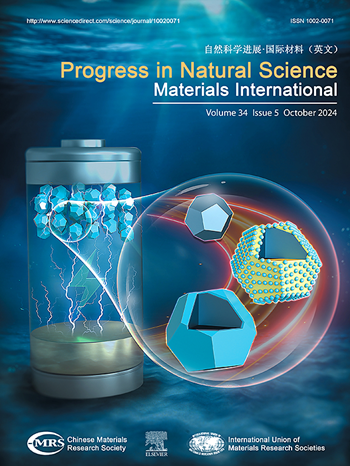界面结构对Ti/Al复合板界面结合强度的影响
IF 7.1
2区 材料科学
Q2 MATERIALS SCIENCE, MULTIDISCIPLINARY
Progress in Natural Science: Materials International
Pub Date : 2025-06-01
DOI:10.1016/j.pnsc.2025.03.006
引用次数: 0
摘要
高温退火过程中在Ti/Al界面处形成较厚的Al3Ti层,降低了Ti/Al复合板的界面结合强度。在本研究中,采用热轧结合低温扩散退火的方法制备Ti/Al复合板,形成纳米级厚度的Al3Ti层。对Ti/Al界面的多尺度结构进行了全面的研究。我们发现退火后的Al3Ti层厚度约为104 nm。与轧制后的Ti/Al复合板相比,退火后的Ti/Al复合板界面结合强度由164.8 MPa提高到191.9 MPa。界面结构由非共相干Ti/Al界面转变为共相干Ti/Al3Ti和半共相干Al/Al3Ti界面的组合。这种界面结构显著提高了界面结合强度。此外,数字图像相关(DIC)结果表明,共相干Ti/Al3Ti和半共相干Al/Al3Ti界面减轻了剪切变形过程中的局部应变集中,从而促进了应变向Ti/Al基体的有效传递。这些发现为开发具有优异界面结合强度的Ti/Al复合板提供了一种新的策略。本文章由计算机程序翻译,如有差异,请以英文原文为准。
The effect of the interface structure on the interfacial bonding strength of Ti/Al clad plates
The formation of a thick Al3Ti layer at the Ti/Al interface during high-temperature annealing reduces the interfacial bonding strength of Ti/Al clad plates. In this study, the Ti/Al clad plates were fabricated using hot rolling combined with low-temperature diffusion annealing, resulting in the formation of an Al3Ti layer with nanoscale thickness. The multiscale structure of the Ti/Al interface was comprehensively investigated. We found that the thickness of Al3Ti layer was formed approximately 104 nm after annealing. Compared to the rolled Ti/Al clad plate, the interfacial bonding strength of the annealed Ti/Al clad plate increased from 164.8 MPa to 191.9 MPa. The interfacial structure transferred from an incoherent Ti/Al interface to a combination of coherent Ti/Al3Ti and semi-coherent Al/Al3Ti interface. Such an interface structure significantly enhanced the interfacial bonding strength. Furthermore, the digital image correlation (DIC) results revealed that the coherent Ti/Al3Ti and semi-coherent Al/Al3Ti interfaces alleviated localized strain concentration during shear deformation, thereby facilitating the effective strain transfer to the Ti/Al substrate. These findings provide a novel strategy for developing Ti/Al clad plates with superior interfacial bonding strength.
求助全文
通过发布文献求助,成功后即可免费获取论文全文。
去求助
来源期刊
CiteScore
8.60
自引率
2.10%
发文量
2812
审稿时长
49 days
期刊介绍:
Progress in Natural Science: Materials International provides scientists and engineers throughout the world with a central vehicle for the exchange and dissemination of basic theoretical studies and applied research of advanced materials. The emphasis is placed on original research, both analytical and experimental, which is of permanent interest to engineers and scientists, covering all aspects of new materials and technologies, such as, energy and environmental materials; advanced structural materials; advanced transportation materials, functional and electronic materials; nano-scale and amorphous materials; health and biological materials; materials modeling and simulation; materials characterization; and so on. The latest research achievements and innovative papers in basic theoretical studies and applied research of material science will be carefully selected and promptly reported. Thus, the aim of this Journal is to serve the global materials science and technology community with the latest research findings.
As a service to readers, an international bibliography of recent publications in advanced materials is published bimonthly.

 求助内容:
求助内容: 应助结果提醒方式:
应助结果提醒方式:


